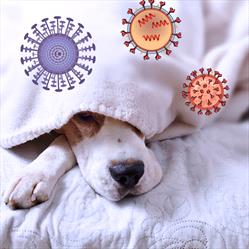J. Scott Weese, DVM, DVSc, DACVIM
The following article has been adapted from the Worms & Germs Blog, by Dr. Scott Weese, DVM, DVSc, DACVIM.
vp_germs_580x580.jpg

CIRDC is endemic (i.e. always present in dog populations), with various known bacterial and viral causes.
Canine Infectious Respiratory Disease Complex or CIRDC is an endemic disease (always present in populations), with various known bacterial and viral causes.
Each year, more and more dog owners ask, “What’s going on with this reported outbreak of respiratory disease in dogs in the US? What new disease is this?”
Veterinarians actually don’t expect a new disease in this situation, and it can be hard to tell the extent of “outbreaks” because of many factors. Various groups have reported respiratory disease, which we refer to as CIRDC in dogs in various parts of the US.
CIRDC signs include:
- A “honking” cough that may sound like retching
- Sneezing, and discharge from the eyes and or nose
- Lethargy, decreased appetite, and labored breathing
- Not all dogs show all of these signs, and each case can be slightly different.
There’s always limited info about the number of dogs with this illness due to a lack of funding for research, no real surveillance system, and testing that doesn’t necessarily change treatment for these dogs. Also, the disease description is usually vague…coughing dogs, some that get pneumonia, and unfortunately, a few that die.
The issue is that this largely describes the normal state. Again, CIRDC is endemic (i.e. always present in dog populations), with various pathogens at play including canine parainfluenza virus, Bordetella bronchiseptica, canine respiratory coronavirus, canine pneumovirus, canine influenza virus, Streptococcus zooepidemicus... roughly in that order of occurrence, and maybe the mysterious bacteria, Mycoplasma. There are also likely a range of viruses that have been present for a long time that we don’t diagnose.
We see CIRDC all the time, everywhere. There’s a background level of disease that usually flies under the radar, alongside periodic clusters. Media and social media can drive outbreak concerns which can be great to get the word out and help sort out issues, but often, they lead to false alarms.
As Dr. Scott Weese explains in his blog, Worms & Germs, “For example, we might have 100 dogs with CIRDC every week in Guelph (Ontario, Canada), a city of about 150,000 people (a complete guess since we have no way to track this). Usually, few people hear about it. The dogs typically get better, and life goes on. However, if someone starts talking about it on social media, we might hear about 50 of those 100 cases. All of a sudden, we have an ‘outbreak of a disease affecting dozens of dogs’ when in reality, we might just have our normal background level of disease that people are noticing.”
The same thing happens more broadly. There are thousands of coughing dogs in the US every day since there are millions of dogs. Once people start talking about it, some of these comments go from, "Oh, my dog is coughing. I guess he picked up something at the park.” to comments like, “My dog has this new disease that’s sweeping the nation."
With the first approach, it's likely that no one but the owner usually knows or is concerned. When people are very worried about their beloved pets, panic, and post on social media, it can lead to further assumptions that things are much scarier or that a “new disease” is developing.
So, what are these reports reflecting?
- A multistate outbreak caused by some new bacterium/virus
- A multistate outbreak caused by our usual suspects, for some reason
- Unconnected sporadic local outbreaks caused by usual suspects
- A slight increase in baseline disease
- Our normal disease activity has resulted in an outbreak of media attention.
Dr. Weese suspects it’s one of the last two and that veterinarians have been seeing a bit more CIRDC activity over the past couple of years, with a somewhat greater incidence of severe cases.
Other factors to consider:
- With more cases, veterinarians see more severe disease.
- Brachycephalic or short-nosed breeds (French bulldogs, pugs, etc.) with a higher likelihood of dysfunctional breathing are very popular and much more likely to have severe outcomes from any respiratory disease.
- Increases in deaths could be linked to the dogs’ physiology, not disease factors.
Things are still unfolding for the veterinary community with CIRDC, but right now there does not appear to be a need for increased concern.
What can you do to protect your dog?
- Limit your dog’s contacts, especially traveling family or friends with dogs of unknown health status.
- Keep your dog away from sick dogs.
- If your dog is sick, keep it away from other dogs.
- Talk to your vet about vaccination against causes of CIRDC including canine parainfluenza (CPIV), Bordetella bronchiseptica, and canine influenza (which is more sporadic and vaccine availability is still an issue).
Overall, if you are concerned that your dog may have CIRDC or that they may be exposed due to certain activities, talk to your veterinarian. They can tell you what may increase their chances of contracting CIRDC and what to look out for based on your pet’s health status.